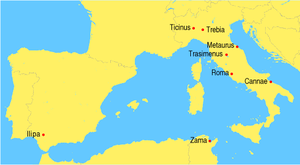| Battle of the Silarus | |||||||
|---|---|---|---|---|---|---|---|
| Part of the Second Punic War | |||||||
 | |||||||
| |||||||
| Belligerents | |||||||
|
|
| ||||||
| Commanders and leaders | |||||||
| Hannibal | Marcus Centenius Penula† | ||||||
| Strength | |||||||
| 25,000-30,000 | 16,000 | ||||||
| Casualties and losses | |||||||
| moderate (probably several thousand) | 15,000 killed, 1,000 wounded or captured | ||||||
| |||||
The Battle of the Silarus was fought in 212 BC between Hannibal's army and a Roman force led by praetor Marcus Centenius Penula. The Carthaginians were victorious, destroying the entire Roman army. This is one of the few battles where Hannibal commanded an army larger than his foes.
Strategic situation[]
Hannibal had lifted the siege of Capua after mauling two Roman consular armies in the battle of Capua. The Roman consuls had split their forces, with Flavius Flaccus moving towards Cumae, while Appius Claudius marched towards Lucania. It is not sure why they had done so, because their forces still outnumbered Hannibal's army, even after with the losses suffered in the battle. Hannibal decided to follow Claudius. Claudius managed to evade the pursuit of Hannibal, but a centurion, Marcus Centenius, had appealed to the Roman Senate for independent command against Hannibal, claiming that with his knowledge of Campania he can best the Carthaginians. Surprisingly, his appeal was granted. 8,000 soldiers were detached to serve under him, possibly from the army of Gracchus which was stationed in Lucania. To this force another 8,000 volunteers from Campania, Lucania and Samnium was added. While Appius Claudius with his consular army marched west to join his fellow consul, Centenius set off to pursue Hannibal. In Iberia, the situation remained deadlocked. Neither the Scipios nor the Barcids gained any decisive advantage. The Siege of Syracuse continued in Sicily. Hanno the Elder remained active in Bruttium.
Battle[]
Although Centenius was a brave soldier, his generalship left much to be desired. According to Livy, he had no idea about the whereabouts of the Carthaginian army. Hannibal's scouts were able to locate the Roman army before the Romans got wind of anything. Marcus Centenius and his army were ambushed by Hannibal and the Roman forces were completely routed. The Roman cause was made worse by the fact their Etruscan allies fled, creating panic in the ranks. Hannibal surrounded the remaining Romans and hacked them down. He then took Marcus's ring from his finger and tried to use it in Marcus's name but to no avail. Once again the Romans showed their persistence by refusal to surrender to Hannibal. Nevertheless Hannibal was still unbeaten on Italian soil. In terms of casualties inflicted, this battle ranks after Cannae among the battles Hannibal had fought. It is said that out of 16,000 Romans, only 1,000 survived. These survivors were sent to join the disgraced legions of Cannae survivors after they had been rounded up.
Aftermath[]
After the Battle, Hannibal did not pursue the Army of Claudius, Instead, he marched east into Apulia, where a Roman army under Praetor Gnaeus Flavius Flaccus was operating against towns allied to Carthage. The Roman consular armies, free of Hannibal, united and resumed their harassment of Capua. Hanno the Elder remained in Bruttium.
The original article can be found at Battle of the Silarus and the edit history here.
